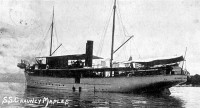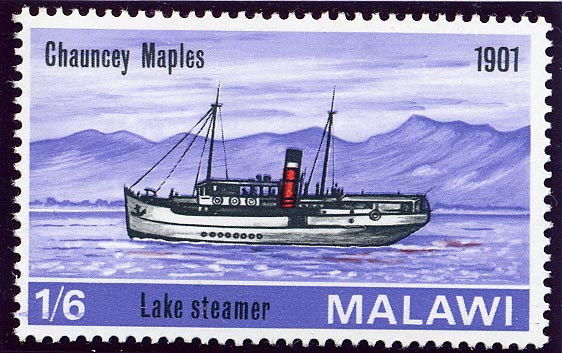Post
by aukepalmhof » Wed Jan 13, 2010 8:06 pm
Built by Alley & MacLellen, Polmadie, Glasgow, England for the Mission Diocese of Likoma, Malawi.
Displ. 250 tons; 127' x 20’; steam engine, one screw speed 9 kn. CHAUNCY is spelled incorrectly on the stamp. . She was named the CHAUNCY MAPLES, in memory of the pioneer missionary and Bishop of Likoma, the Rt. Rev. Chauncy Maples who was tragically drowned in Lake Nyassa (currently called Lake Malawi) in 1895. The Universities Mission to Central Africa commissioned the steamer when the UMCA’s first vessel, the CHARLES JANSON, could no longer cope with the workload around the lake. An appeal for funding had been launched in 1897 in order to build a second and larger steamer. The chief engineer on the mission station produced preliminary plans for a good vessel to withstand the rough conditions sometimes experienced on Lake Nyassa, and also approach very near to shore with safety and ease. The engines were run in 1899 with the power absorbed by a dynamometer, and in October 1899, she was dismantled and shipped from Glasgow to Chinde. All the parts, plates, bolts and components were marked, taken to pieces and sent for galvanizing in hot dip zinc. On completion of this, everything was packed into 3,500 packages: most weighed under 56 pounds, the largest and heaviest being the boilers, weighing 9.5 tons. All the packages were shipped to the Zambesi on the HOLLINGSIDE. In 1900-01, she was transported 350-miles to Lake Nyassa and reassembled, altogether 35,000 rivets were used. Shipping the boiler to Africa was a relatively straightforward affair, but from the port side at Chinde, there still remained a 350-mile trek across Africa by river and road. Towing the boiler on barges on the first leg of the journey up the Zambesi presented no real problems. When the river became blocked by waterfalls or rapids, however, the barges had to be unloaded and the boiler carried overland. A special carriage with traction engine wheels had been constructed and at various points on its journey, as many as 450 Angoni tribesmen were enlisted to pull the load up the steep hills and across boulder-strewn river beds. They averaged about three miles a day. On May 23-24, 1901, CHAUNCY MAPLE was launched at Mponda, with difficulty. She was then fitted out at Malindi, originally with auxiliary sails, but these were later discarded. The complete cost was: hull, engines and galvanizing: £9,000; transport: Glasgow to Lake Nyasa: £5,500; and re-assembly: £2,200. Alley & MacLellan were the largest of the shipbuilders not having a yard on the riverside, and for this reason, specialized in building ships which had to be dismantled and rebuilt where they were to go into service. Formed about 1890 they became part of the Beardmore group in 1918, becoming independent again in 1937 and surviving until 1960 having built some 500 ships. On December 21, 1901, CHAUNCY MAPLE made her first trials. In January 1902, trials completed and she entered service for the Diocese of Likoma. From 1914-18, she was commandeered for the British Naval Forces at Lake Nyassa. In 1921, she was refitted and returned to service, but only for cargo for the Diocese of Likoma. In 1939, she was requisitioned by the British forces. The boiler gave out in 1943, and could not be replaced due to the war. In 1946, she was reboilered and entered service again. Laid up in 1953 due to lack of finance, she was sold in 1956 to a fishing company and converted to a refrigerated mother ship for the Lake Malawi fishing fleet. In 1965, she was purchased by the Malawi Railways which converted her to a modern diesel passenger and cargo ship. She began her new service in 1968, the only old steamer still in active service. The original steam engine and other relics are in the Lake Malawi Museum at Mangochi. According the latest report (1985) she was moored, afloat, but in a non-operational state, at the Monkey Bay yard of the Malawi Lake services (previously Malawi Railway), which has now been privatized.
2009 She is now owned by the Government of Malawi, which plans to renovate her as a floating clinic.
Free health care
Lake-side villagers will receive free treatment for common diseases, maternity care, simple operations, dentistry, immunisation for their babies, family planning and information on hygiene and safe sex.
Green engineering
The fuel used to run the CHAUNCY MAPLES' diesel engine will contain a proportion of bio-diesel made from jatropha – a non-edible tropical plant growing in Malawi. This will also create employment and reduce fossil-fuel imports.
Sources: David Asprey, Lake Malawi Steamers; Log Book, Vol. 28 page 236; Song of the Clyde-History of Clyde Shipbuilding; The building of the CHAUNCY MAPLES, published in 1903; Malawi P.O. Stamp Bulletin; HS-C 6; T.F. Barrett; WP 24:42/52, 32:60.
-
Attachments
-


